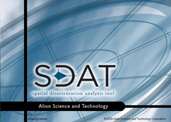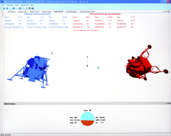Modeling and Mitigating Spatial Disorientation in Low-Gravity Environments

Start-up screen from the Spatial Disorientation Analysis Tool (SDAT). Click here for larger image.
Principal Investigator:
Ronald L. Small
Organization:
Alion Science and Technology Corp.
When flying aircraft, pilots sometimes experience dangerous spatial disorientation (SD) issues including leans, Coriolis, and graveyard spiral illusions, and disparities between actual and perceived pitch attitude, roll rate or yaw rate. Ronald L. Small and colleagues are working to extend SD mitigation software, originally developed for aeronautical use by the private company Alion Science and Technology Corp., for use in exploration vehicles, surface modules and exploration mission programs. The Alion researchers are working closely with scientists at MIT.
The Spatial Orientation Aiding System is a real-time cockpit aid that assesses multi-sensory workload to determine the types of countermeasures to initiate and when. The Spatial Disorientation Analysis Tool technology is used for post-flight analyses of aircraft trajectory data to determine the presence or absence of vestibular spatial disorientation. The team is testing these technologies on their ability to predict an SD event and whether they will be beneficial for space use.
NASA Taskbook Entry
Original Aims
The goal of this industry-university research and development project is to extend Alion's spatial disorientation mitigation software, originally developed for aeronautical use, to NASA's space applications for exploration mission vehicles.
Alion's spatial disorientation analysis tool (SDAT) is designed for post hoc analyses of aircraft trajectory data from U.S. Navy, Air Force and National Transportation Safety Board mishaps to determine the presence or absence of vestibular spatial disorientation (SD). Spatial orientation aiding system (SOAS) is a real-time cockpit aid that has been evaluated in simulators with rated pilots.
Both tools incorporate models of the vestibular system and assessor heuristics to predict the epoch and probability of an SD event such as leans, coriolis or graveyard spiral illusions, as well as any other significant disparities between actual and perceived pitch attitude (somatogravic), roll rate or yaw/heading rate. SOAS assesses multi-sensory workload to determine the types of countermeasures to trigger and when to trigger them.
Project Aims
- Enhance the utility of SDAT/SOAS by including appropriate mathematical models for vestibular and visual sensory cues, and central nervous system gravito-inertial force resolution into perceived tilt and translation estimates from Massachusetts Institute of Technology's (MIT) Observer model, and revalidating it using existing aeronautical data sets.
- Extend the models to describe zero gravity, shuttle, and Altair landing illusions, validating the models using Shuttle and Altair simulator data sets and current (e.g., theories rotation otolith tilt-translation reinterpretation).
- Extend SDAT/SOAS to consider multiple visual frames of reference, the effects of visual attention and sensory workload, and the cognitive costs of mental rotation and reorientation. The enhanced SDAT/SOAS from Aims 1-3 will be validated via simulator and/or flight experiments.
Key Findings
During the project's third year, we focused on merging MIT's Observer perception models with Alion's SDAT we enhanced both Observer and SDAT based upon data set analyses, verification tests, and comparisons of analytical results produced by the two models.
We validated the Observer via comparison to perception data from NASA Ames Research Center's vertical motion simulator (VMS) lunar landing simulator experiment (in collaboration with Dr. Lawrence Young's NSBRI-funded lunar landing project at MIT) and a dynamic swinging experiment (in collaboration with Dr. Rader and Dr. Merfeld at the Massachusetts Eye and Ear Infirmary).
We obtained helicopter spatial disorientation event data sets for verification and validation tests, validating and enhancing our visual frame of reference transformation (FORT) tool and creating a space shuttle orientation survey for commanders and pilots. Due to the Constellation program changes, we broadened our focus to include helicopter and fixed-wing aircraft disorientation scenarios and space shuttle orientation issues. MIT's Observer has been enhanced with visual inputs and calculations to account for the impact of visual cues on a human's perception of attitude, velocity and displacement.
Validations of Observer included linear and angular acceleration steps, post-rotation tilt, vertical yaw rotations (with and without vision cues), somatogravic illusions (linear acceleration with and without vision cues, and fixed and variable radius centrifugation), static and dynamic roll tilt, off-vertical axis rotation, large amplitude horizontal and vertical sinusoidal displacements, circular vection, linear vection, Coriolis and pseudo-Coriolis illusions, and astronaut post-flight tilt-gain and tilt-translation illusions.
To facilitate integration with SDAT, a stand-alone version of Observer was developed called eObserver. eObserver does not require a MatLab license to run. It includes a graphical user interface (developed by Alion) to ease data file selection and processing step selections.
Vestibular threshold literature was studied to determine the best way to represent semicircular canal and otolith thresholds within Observer as a prerequisite for replacing SDAT's vestibular attitude calculator with Observer. The visual FORT tool was validated and modified using the available literature to adjust FORT costs and achieve higher correlations with previous experimental data. SDAT/SOAS is being enhanced with illusions heuristics for pilots of vertical landing vehicles. Our approved survey of shuttle commanders and pilots seeks to capture the experiences of these crew members before the shuttle is retired. It asks questions about illusory sensations and how each respondent coped with those sensations, if he/she experienced any. The survey was peer reviewed and will be revised to accommodate peer comments as well as suggestions from the first two respondents.
Impact of Key Findings on Original Aims
The most important impacts from Year 3 are that we now have a method for integrating Observer into SDAT, a plan for integrating FORT costs into SDAT, new illusion heuristics for vertical landing vehicles (e.g., helicopters and lunar landers), helicopter SD event data sets for verifying and validating perception models and enhancements, and a survey with which to capture the prevalence and severity of space shuttle orientation issues.
Proposed Research Plan for Year 4The Alion-MIT team will:
- Complete enhancements to, and the merging of, SDAT and Observer, and continue comparing analytical results of common data sets.
- Validate enhancements with previous aircraft flight data sets and new data sets from actual vehicles and simulators. Included will be helicopter SD event data sets and data sets from space vehicle simulators (e.g., NASA Ames Research Center's VMS).
- Incorporate FORT tool scores into SDAT calculations of SD probability.
- Characterize the prevalence and severity of space shuttle re-entry and landing orientation issues.
- Plan and conduct experiments to generate validation data (e.g., vertical motion threshold data) and/or to demonstrate the value of SD countermeasures.
An important goal of this research and development project is to enhance Alion’s spatial disorientation analysis tool (SDAT) and spatial orientation aiding system (SOAS) and Massachusetts Institute of Technology’s Observer human perception model, so that the combined system accurately detects and classifies spatial disorientation events, and triggers the appropriate countermeasures for the situation. The combined system will be useful for aircraft pilots, space travelers, accident investigators, flying safety officers and physiologists. This wide range of applicability is due to the intentional design of the system’s components (i.e., SDAT, SOAS and Observer) to be useful for post-hoc analyses and for in-cockpit pilot aiding.







